The last destinations of the season: Sivota, Paxos, Parga, Ammudia
We’ve been very busy lately, which is why we’re a little behind with our reports. Mea culpa. We had come up with a brilliant plan for the end of the season: from mid-September, when it would be less crowded, we would visit a few select places that were too busy during the season. On the list: Paxos, Antipaxos and other places that only have room for a few boats.
According to our theory, there would be significantly fewer charter boats on the water and many sailors would already be on their way to Italy or seeking Schengen refuge in Turkey, Montenegro or Tunisia. A nice plan, but unfortunately completely off the mark. It felt like it got even busier at the end of September. Presumably, the charter companies had been advertising in Eastern Europe and Russia, because you hear almost only Slavic languages on the countless charter boats, with crews that are often completely overwhelmed oder underskilled.
Sivota – Mainland
From Corfu, we sailed towards the mainland with little wind and calm seas, heading for the charming Sivota for three hours. One of many places with this name.
It roughly means ‘where the pigs graze’. This Sivota is a small village without pigs. There is a bit of tourism, but it is sophisticated. The offshore islands offer a wonderful water landscape. In a bay off the town harbour, we found a pleasant anchorage in 8 m deep, clear water on a sand/mud bottom with very good holding. In the many bays around, there are a few nice smaller hotels and, for their guests, a wonderfully sheltered sea and very beautiful sandy beaches.
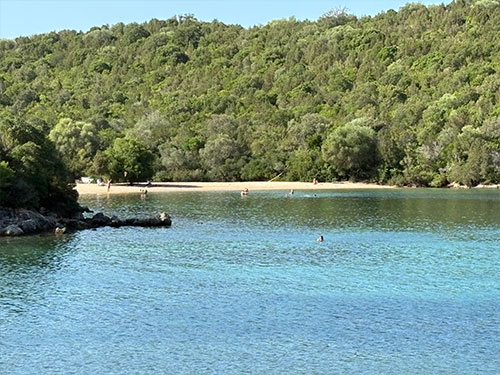
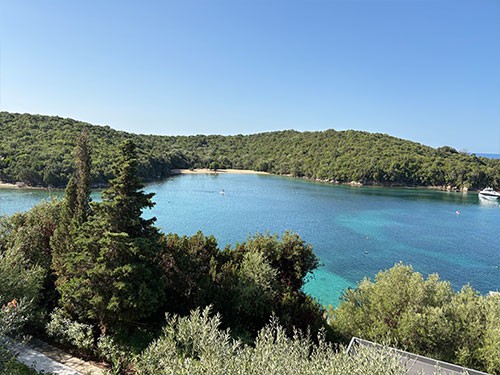
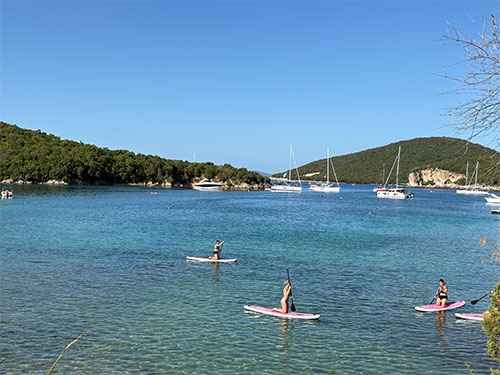
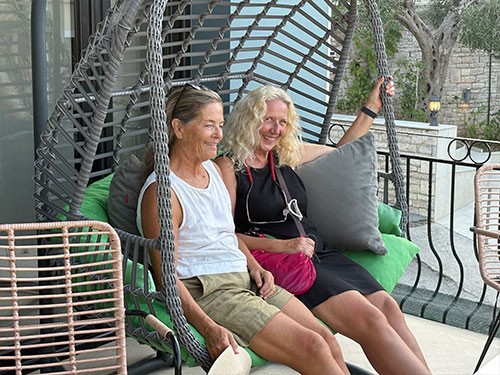
beautiful water scenery in Sivota
Paxos/Gaios
We had been looking forward to visiting the island of Paxos all season. 1,400 of the 2,300 inhabitants of Paxos live in the village of Gaios, our destination. A stone dock stretches along the village on the banks of a well-protected canal. To get a berth, you have to arrive at the right time and on the right day – and be lucky, even in September. It’s first come, first served, and many of the yellow-marked berths can only be occupied from 4 p.m. to 11 a.m. the following day. Just as we arrived, a Hallberg Rassy 54 and a small monohull vacated our future berth. If you can’t find a place at the community dock, the alternatives are few and far between. To the north, next to the ferry dock, there is a small but expensive jetty, and to the south, outside the canal, there is a poor, stony anchorage where 25 desperate yachts were looking for a place to moor on a Monday.Die letzten Ziele der Saison: Sivota Paxos Parga Ammudia
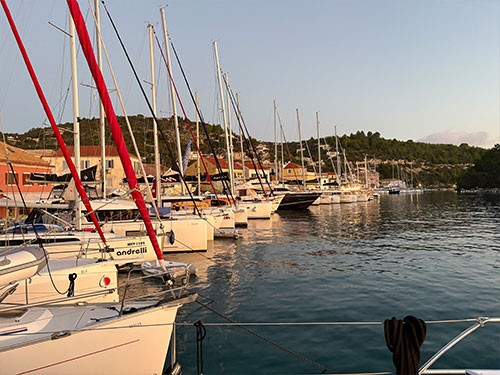
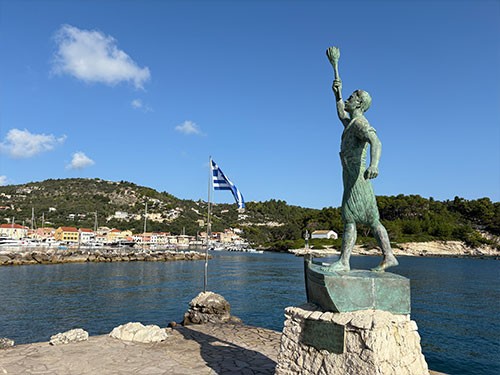
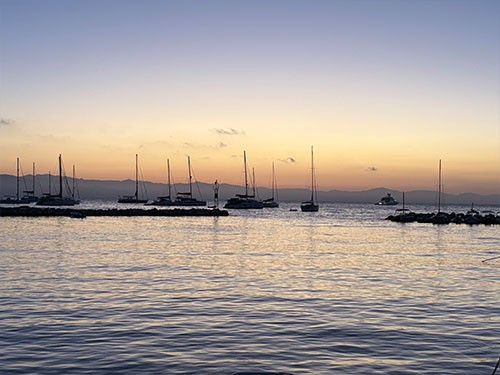
Crowded community dock, harbour entrance, vessels at the southern, rocky anchorage because everything is full
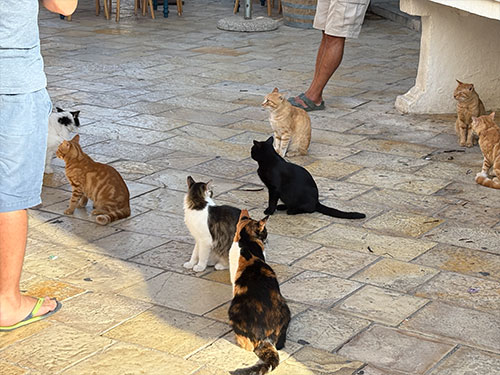
in front of the fishmonger
Gaios is very charming. Paxos is currently very en vogue in Greece, as is unfortunately the entire Ionian Sea. One of the reasons for its popularity can be found on Netflix. There is a Greek production called ‘Maestro in Blue’ that is set in and around Paxos, especially in Gaios. Rivercafe was located ten metres away from one of the main filming locations.
You see a lot of Paxos in the series, and it really is that beautiful. Paxos is cashing in on this popularity. Normally in Greece, the community docks are very cheap, but in Gaios we paid €60 (cash only) per night. A monohull of our size paid €40, without water, electricity or mooring lines. Our Rivercafe was in need of a good desalination washdown again, but there was no fresh water. The island suffers from a dramatic water shortage and even households often have sometimes no water, as we later learned. However, that didn’t stop the saleswoman from selling us a data card for non-existent fresh water.
In Gaios, we already had a feeling that our formidable theory – empty from September onwards – was an incredible flop. It was packed, and every day there was a battle for a berth. Not quite as wild as in Hydra, but not far off.
Mooring a boat at the dock in Gaios is no easy feat. Because it is very narrow, you have to position your bow anchor very precisely between the chains already lying on the seabed so that you don’t obstruct or pull out other chains or anchors. The three days of our stay were a maritime freak show.
A scary amount of skippers were hardly a credit to their kind. Our neighbour on the first night, according to his shirt the ‘sailing instructor’ of a Polish crew, took an hour and at least six attempts to moor his charter boat at the dock next to us – in calm winds. In the process, he pulled several anchors and chains from other ships off the seabed. During the days, we saw plenty of snagged anchors and retrieved chains, lots of shouting and cursing from other vessels and more than one escalation.
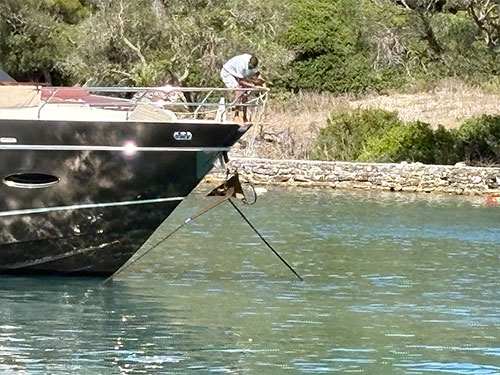
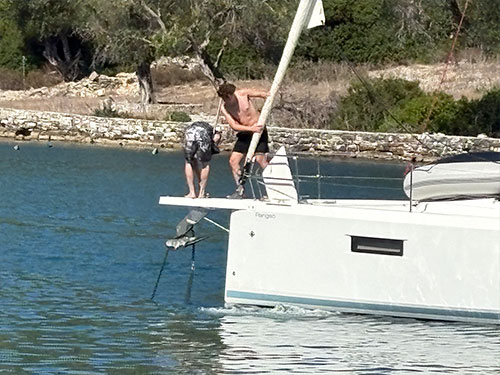
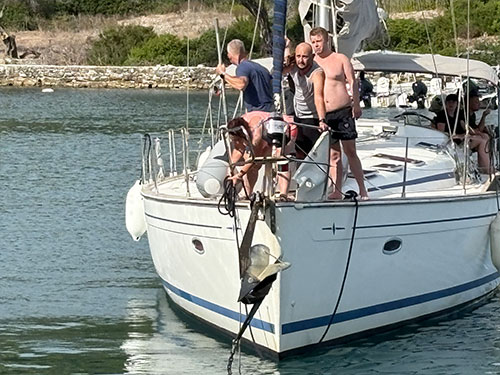
Anchor chaos, never getting boring in the afternoon
After three days, we had had enough of the stress of protecting Rivercafe from moorers and set off. A visit to Antipaxos was out of the question. It was far too crowded to find a safe place in one of the two anchorages. When you see ships anchoring with fenders, it’s better to turn around immediately.
Parga (Pargas)
Refreshed by a dose of Paxos, we headed for Parga on the mainland instead of Antipaxos, on the recommendation of our friend Lorenz. (Dear Lorenz: now we have two topics on which we strongly disagree). As we approached, we encountered easily 30 vessels coming out of the bay, so we found a good anchorage at 7 m in sandy ground. Anchoring in the village itself is punishable by a fine (€500), so the anchorage is a little further north. Parga is a hardcore tourist resort, with hundreds of beach loungers, plenty of knick-knack shops and an unsightly amount of water sports for tourists: parasailing, water skiing, towable tubes and everything else that is loud and useless.
The hardware, i.e. the landscape and the coast, is very beautiful. Green mountains, a fortress and clean water. Unfortunately, that’s all the good things I have to say about Parga. The wind and wave protection are not good and, for the first time in Greece, we felt unwelcome as yachties.
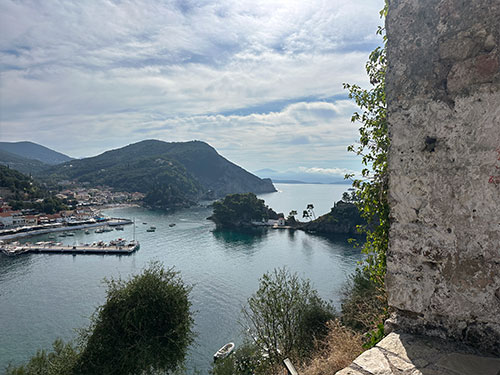

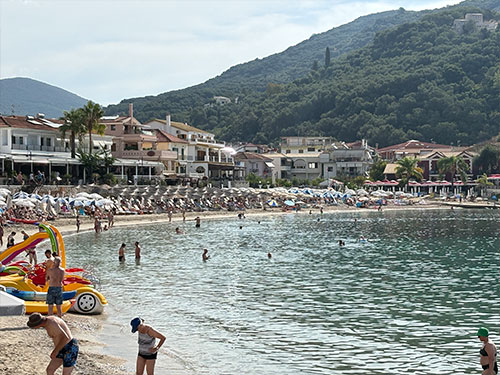
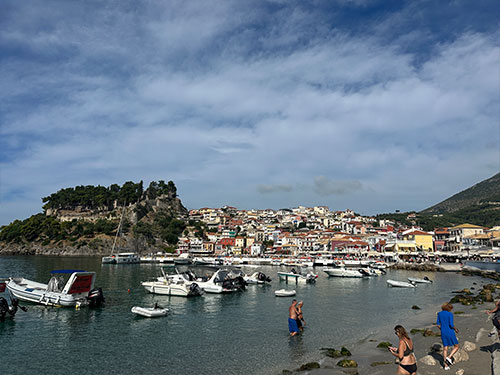
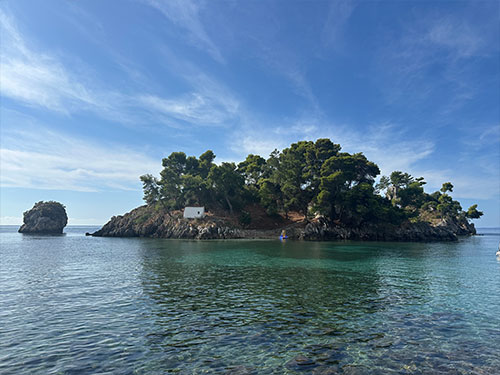
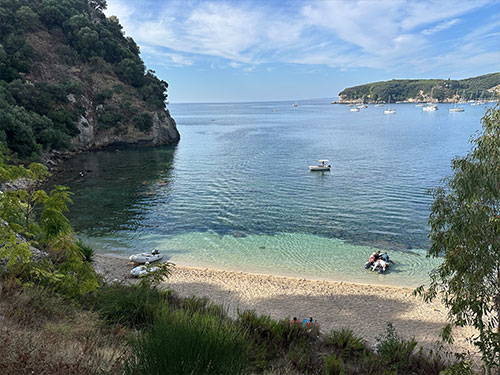
Parga, actually beautiful but not pleasant
Jet skis and speedboats with dubious water activities race around between the anchored ships. The closer they get to the anchored vessls, the better. Our sailing friend Michael told us that a parasailer was pulled into the spreader of his yacht by a motorboat and got stuck 15 metres up. It’s only a matter of time before Parga appears in the news.
It is obvious that they do not want sailors in Parga. As a landlubber, it would annoy me too, because it is really much too crowded. The AIS showed the signals of 9 vessels, but in fact there were 70, almost 90% of which had no AIS signal. And an alarming number of these 70 skippers were unable to anchor propperly.
On Wednesday, a maximum wind speed of 20 knots from the north-west was forecast for 3-4 hours. In fact, it reached 28 knots over many hours, veering strongly until late into the night. These 8 knots more are twice as strong as forecast in terms of wind pressure. We had good holding, but had to keep a night watch to see if any of the often overly optimistic neighbouring ships anchored nearby were drifting towards us.
The situation became even more unpleasant because most of the vessels were abandoned. In Parga, it is not possible to take a dinghy to the village as there is no dinghy dock. This was probably taken care of by the water taxis. For an immodest fee of €7 per person for a one-way trip, they pick up guests from the vessels and take them to the village, which is 5 minutes away. Apparently, many crews thought this was cool, ignored the steadily increasing and shifting wind, and disembarked. Lucky us, next to us was a pro skipper who stayed on board and re-anchoraged during the night.
Parga remains in our memory as the most unpleasant place we have ever visited in Greece. At least we’ve taken the top spot in that category.
Back to paradise
The most diverse places can be so close together. Just an hour away was the exact opposite of Parga. Ammoudia is a picturesque bay that is three-quarters enclosed by land.
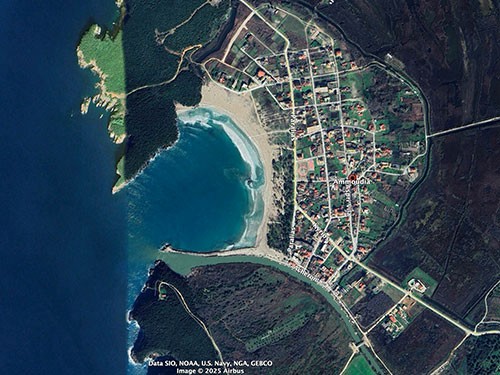
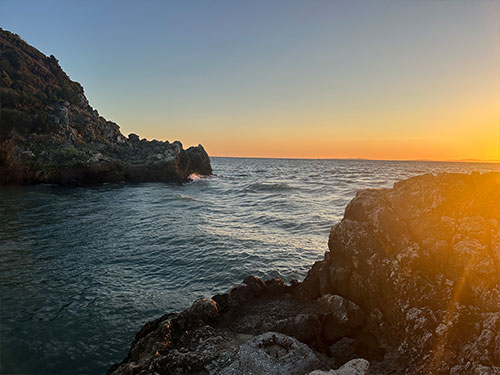
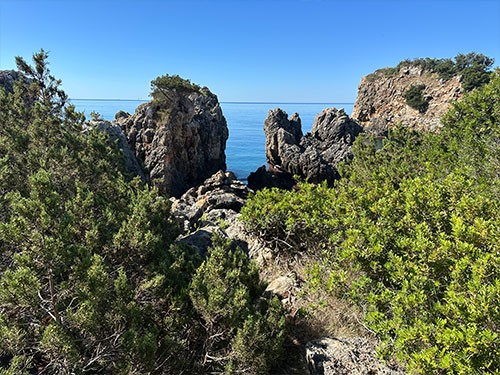
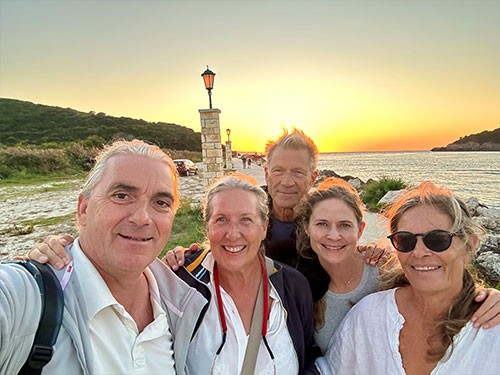

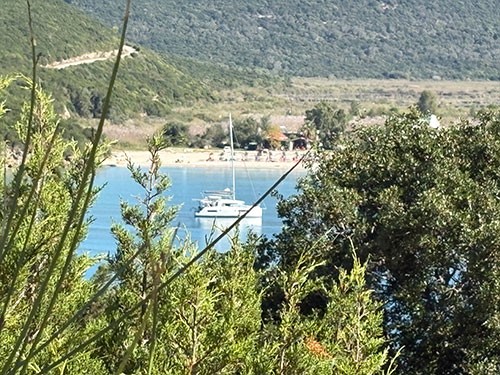
Google earth image of Ammoudia, Acheron before it gets choppy, good times and hikes with friends, Rivercafe alone in the bay
With a sleepy village and one of the most beautiful sandy beaches we saw in Greece. Quiet and peaceful, without jet skis and the like. Everything very basic, but beautiful and… empty. We were alone at times until our friends from the Fram arrived. The anchorage is poorly rated on Navily, and that’s because of the afternoon NW swell, which makes it uncomfortable for a few hours. From 3 p.m. onwards, its impossible to enter the Acheron River flowing next to the bay with the dinghy without getting wet. An uncomfortable afternoon wind does the rest, but everything calms down again around 8 p.m. However, the anchorage with sand and mud is excellent and the water is clear and clean, well suited for making fresh water and swimming.
Birthday stopover
It’s hard to believe, but even when sailing, you get older. My birthday was coming up. Our friends from the Fram, Margaret and Dan, postponed their departure for Sicily to celebrate my birthday with our friends. We moved to Two Rocks Bay, which is unfortunately becoming increasingly popular. There is space for about 15 vessls, but 30 ended up anchoring there, recklessly close together.

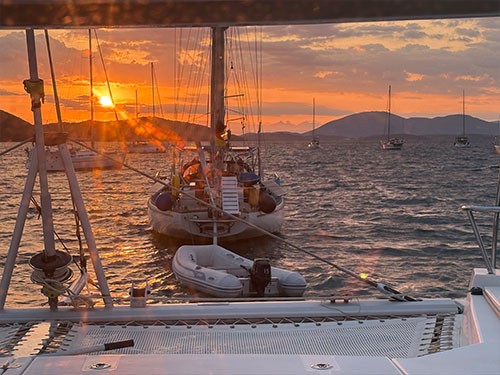
Sailors with distance problems
Ignoring that, it was a relaxed birthday celebration at a lovely but very simple beach bar. We enjoyed the crystal-clear water for the last time this season on our final swimming and paddling trips.
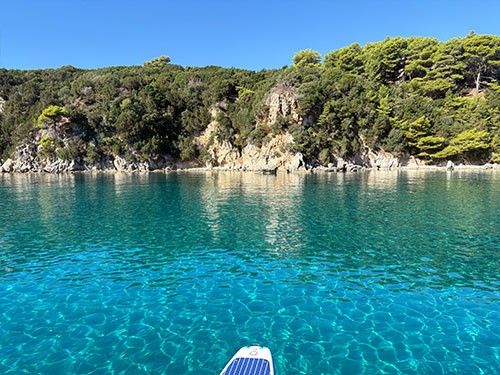
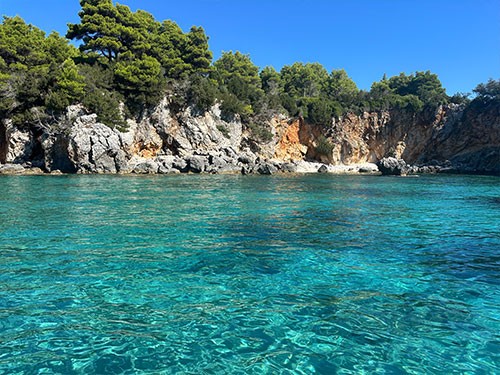
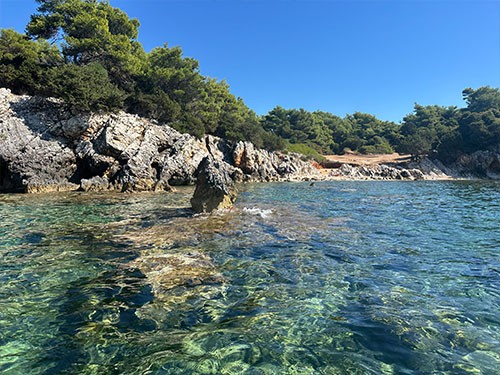
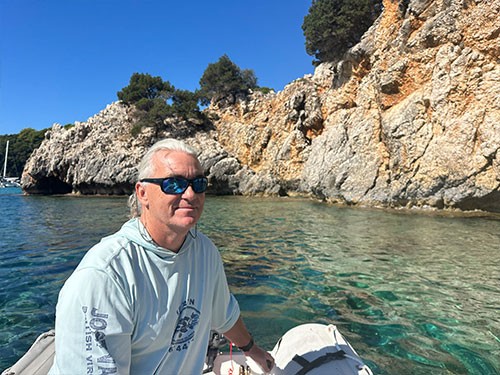
Now we have the last 30 nautical miles of the season ahead of us, to Preveza, the location of our winter storage facility. /Holger Binz

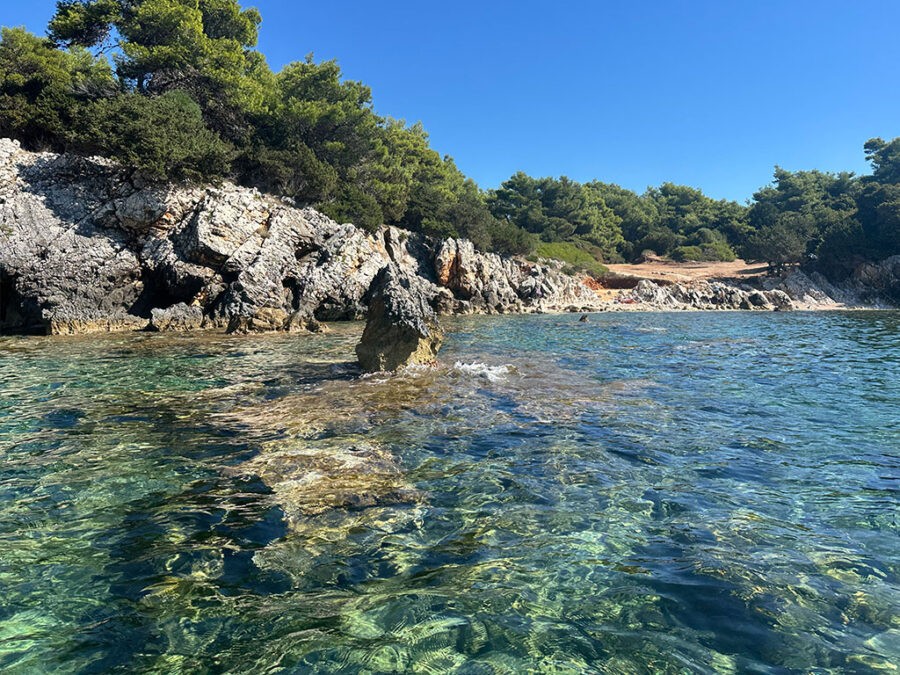
Ihr Lieben … hatte Sehnsucht nach euch…unser Treffen war zu kurz… super informativ euer Bercht, werde jetzt mal öfters bei euch „reinschauen“. Viel Spass mit der Family und erfreuliches Bauen, wir sehen uns, Ulli